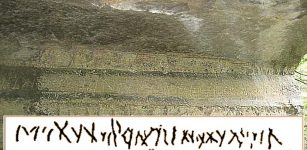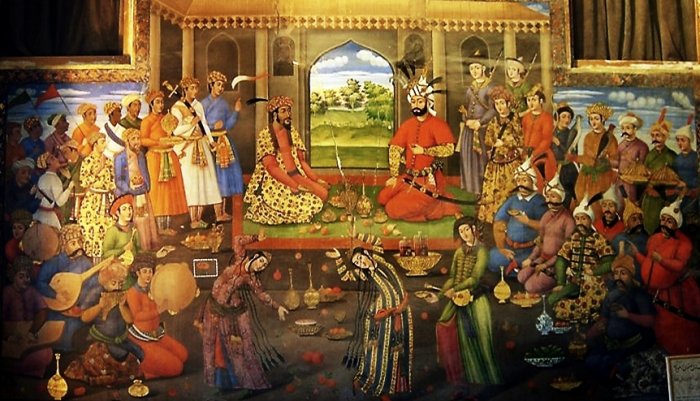Ancient History Of New Year’s Celebrations And Traditions From Around The World
A. Sutherland - AncientPages.com - Have you ever wondered how our ancestors celebrated New Year's Eve worldwide? The history of New Year celebrations goes back to ancient times, and some traditions have survived for thousands of years.
Babylonian Akitu Festival
Front of the throne base of Shalmaneser III of Assyria, showing the Assyrian king and Marduk-zakir-šumi I of Babylon shaking hands in a public display of Assyro-Babylonian friendship. From Kalhu. Iraq Museum. Credit: Osama Shukir Muhammed Amin FRCP(Glasg) - CC BY-SA 4.0
The earliest known New Year celebrations were in Mesopotamia and date back to 2000 B.C. Following the first New Moon after the vernal equinox in late March, the Babylonians of ancient Mesopotamia would honor the rebirth of the natural world with a multi-day festival called Akitu.
During the Akitu, statues of the gods were paraded through the city streets. All significant rites were enacted to symbolize their victory over the forces of chaos. The Babylonians believed the world was symbolically cleansed with the help of rituals and recreated by the gods. The goal was to prepare for the New Year and spring return.
Wepet Renpet: Ancient Egyptian New Year
Goddess Seshat from the back of the throne of a seated statue of Ramesses II, Luxor temple. Credit: Jon Bodsworth - Public Domain
In ancient Egypt, New Year was closely tied to the Nile River. The Egyptian New Year celebration Wepet Renpet which means the year's opening, was based on the annual flooding of the Nile River.
In July, ancient Egyptian priests watched how Sirius, the brightest star in the night sky, became visible after a 70-day absence. The return of Sirius marked the New Year and the coming flood. It was then time to reset the calendar and celebrate a new year.
The New Year was a time of rebirth and rejuvenation. It was honored with feasts and special religious rites.
Archaeologists found evidence at the Temple of Mut that New Year celebrations in Egypt also included the "Festival of Drunkenness."
Samhain celebrations in Ireland. Credit: Wikipedia -CC BY-SA 4.0
The Celts celebrated their New Year on November 1. The Festival of Samhain marked the end of the Celtic year and the beginning of the new one and can be seen as the equivalent of New Year's Eve. It was also a time when the veil between this world and the Otherworld was so thin that the dead could return.
Many people lit bonfires to keep the evil spirits at bay. Food was set aside for ancestors. Often a torch was lit and carried around the boundaries of the home and farm. It had symbolic but also a vital meaning to protect the property and residents against the spirits throughout the winter.
Samhain is one of eight annual festivals commonly celebrated by pagans of various traditions, along with Yule, Imbolc, Ostara, Beltane, Midsummer, Lughnasadh, and Mabon.
Nowruz - Persian New Year
A 16th-century painting of Tahmasp I and Humayun celebrating Nowruz. Isfahan-Chehel-Sotoon-Museum. Credit: Public Domain
The history of Nowruz, the Persian New Year, can be traced to the Zoroastrian religion. Historical records show Nowruz's celebration dates back at least as far as the 6th century B.C. and the rule of the Achaemenid Empire founded by Cyrus the Great, one of the most outstanding figures in human history. Nowruz is still celebrated today in Iran and other parts of the Middle East and Asia.
Nowruz always begins on the first spring day marked by the vernal equinox, or Tahvil. On that day -which may occur on March 20 – 21 or 22 – the Sun crosses the celestial equator.
To Zoroastrians, the return of spring represented an annual victory for the spirit of the Sun. It was when the Sun began to regain strength and overcome winter's cold and darkness, and there was a renewal of growth and vigor in nature. About 300 million people celebrate Nowruz, and many of its ancient traditions—particularly the use of bonfires and colored eggs—remain a part of the modern holiday.
Chinese New Year And Nian
The largest Chinese New Year parade outside Asia in Chinatown, Manhattan. Credit: Patrick Kwan - CC BY 2.0
The tradition of celebrating New Year started over 3,000 years ago during the Shang Dynasty. An ancient legend tells that Nian, a bloodthirsty creature, used to prey on villages every New Year. To frighten the hungry beast, the villagers took to decorating their homes with red trimmings, burning bamboo, and making loud noises. The ruse worked, and the bright colors and lights associated with scaring off Nian eventually integrated into the celebration.'
See also:
Hogmanay: Scotland's New Year Celebration Inherited From The Vikings
The Chinese New Year celebrations last 15 days. People clean their houses to rid of bad luck, and some repay old debts to settle the previous year's affairs.
Ancient Romans' New Year
Roman coins depicting Janus. Credit: Classical Numismatic Group, Inc. - CC BY-SA 3.0
In the old Roman calendar, the first month of the year was Mars and their New Year was a festival called Calends or Kalends. God Janus represented beginnings and ends; his name means "gate" or "door." In times of war, the gates of his temple were kept open, and in peacetime, they were barred. People decorated their homes with lights and greenery and gave each other gifts carefully chosen for their luck-bringing properties.
Ancient Romans should think good thoughts during the New Year's celebrations and avoid gossiping.
The Roman calendar was constantly being tampered with by the Emperors. It became out of synchronization with the Sun. To set the calendar right, the Senate, in 153 B.C., proclaimed that the first day of a New Year would be observed on January 1.
The two-faced god Janus was lord of this day. January is named after him.
Ancient Romans continued to change their calendar until 46 B.C. when Julius Caesar established what was later known as the Julian Calendar. Again, it designated January 1 as the New Year. However, Caesar was obliged to allow the previous year to continue for 445 days to synchronize the calendar with the Sun.
Updated on December 26, 2023
Written by – A. Sutherland - AncientPages.com Senior Staff Writer
Copyright © AncientPages.com All rights reserved. This material may not be published, broadcast, rewritten or redistributed in whole or part without the express written permission of AncientPages.com
Expand for referencesMore From Ancient Pages
-
 Secrets Of 160,000 Ancient Texts Kept In The Abbey Library Of St. Gall May Soon Be Unlocked By AI
Linguistic Discoveries | Aug 23, 2021
Secrets Of 160,000 Ancient Texts Kept In The Abbey Library Of St. Gall May Soon Be Unlocked By AI
Linguistic Discoveries | Aug 23, 2021 -
 Suomenlinna Fortress: Impressive ‘Castle Of Finland’ Has Rich History
Featured Stories | Feb 13, 2016
Suomenlinna Fortress: Impressive ‘Castle Of Finland’ Has Rich History
Featured Stories | Feb 13, 2016 -
 Abu Erteila’s Lost Temple And The Meroitic Empire: New Discoveries Shed Light On Nubian Civilization
Archaeology | Jan 14, 2016
Abu Erteila’s Lost Temple And The Meroitic Empire: New Discoveries Shed Light On Nubian Civilization
Archaeology | Jan 14, 2016 -
 On This Day In History: 55 Delegates Convened To Write What Would Become The U.S. Constitution – On May 14, 1787
News | May 14, 2016
On This Day In History: 55 Delegates Convened To Write What Would Become The U.S. Constitution – On May 14, 1787
News | May 14, 2016 -
 Mystery Of The Ancient Sitovo Inscription: Undeciphered Script Or Just A Natural Rock Formation?
Featured Stories | Apr 17, 2016
Mystery Of The Ancient Sitovo Inscription: Undeciphered Script Or Just A Natural Rock Formation?
Featured Stories | Apr 17, 2016 -
 3,000-Year-Old Nimrud Lens Could Re-Write The History Of Science – Was The World’s Oldest Telescope Developed By Ancient Assyrian Astronomers?
Ancient Technology | Oct 19, 2014
3,000-Year-Old Nimrud Lens Could Re-Write The History Of Science – Was The World’s Oldest Telescope Developed By Ancient Assyrian Astronomers?
Ancient Technology | Oct 19, 2014 -
 A Head Of A Statue Dated To 700 BC, Animal Figurines And Jordan Valley’s Occupation History
Archaeology | Sep 1, 2018
A Head Of A Statue Dated To 700 BC, Animal Figurines And Jordan Valley’s Occupation History
Archaeology | Sep 1, 2018 -
 Secret Dwelling Place Of Reptilian And Dragon-Like Creatures In Europe
Featured Stories | Jul 18, 2018
Secret Dwelling Place Of Reptilian And Dragon-Like Creatures In Europe
Featured Stories | Jul 18, 2018 -
 Maya Site With At Least 300 Buildings Some Of Which Are Over 8 Meters High – Discovered
Archaeology | Sep 16, 2022
Maya Site With At Least 300 Buildings Some Of Which Are Over 8 Meters High – Discovered
Archaeology | Sep 16, 2022 -
 1,200-Year-Old Viking Sword Found By Hiker In Norway
Archaeology | Oct 22, 2015
1,200-Year-Old Viking Sword Found By Hiker In Norway
Archaeology | Oct 22, 2015 -
 3,500 Underground Man-Made Maresha/Beit Guvrin Caves And Tunnels In The Holy Land
Featured Stories | Jun 1, 2014
3,500 Underground Man-Made Maresha/Beit Guvrin Caves And Tunnels In The Holy Land
Featured Stories | Jun 1, 2014 -
 Extremely Brutal Conflicts Among Maya Broke Out Before Civilization’s Decline
Archaeology | Aug 8, 2019
Extremely Brutal Conflicts Among Maya Broke Out Before Civilization’s Decline
Archaeology | Aug 8, 2019 -
 Antediluvian Discoveries In Britain, Germany And France That Could Re-Write History
Featured Stories | Jan 4, 2019
Antediluvian Discoveries In Britain, Germany And France That Could Re-Write History
Featured Stories | Jan 4, 2019 -
 Evidence People Lived In Australian Desert 50,000 Years Earlier Than Previously Thought
Archaeology | Sep 22, 2018
Evidence People Lived In Australian Desert 50,000 Years Earlier Than Previously Thought
Archaeology | Sep 22, 2018 -
 Mystery Of The Wizard Clip – Unexplained Half-Moon Clippings And Supernatural Phenomena West Virginia
Featured Stories | Jul 15, 2024
Mystery Of The Wizard Clip – Unexplained Half-Moon Clippings And Supernatural Phenomena West Virginia
Featured Stories | Jul 15, 2024 -
 Disappearance Of The El Argar Civilization – Why Has No One Lived In The La Almoloya Region Again?
Civilizations | May 10, 2022
Disappearance Of The El Argar Civilization – Why Has No One Lived In The La Almoloya Region Again?
Civilizations | May 10, 2022 -
 Mysterious Dark Watchers – One Of America’s Greatest Ancient Riddles
Featured Stories | Nov 13, 2014
Mysterious Dark Watchers – One Of America’s Greatest Ancient Riddles
Featured Stories | Nov 13, 2014 -
 Unexplained Disappearance Of East Balkan Civilizations – Scientific Disagreement – Part 2
Civilizations | Apr 30, 2018
Unexplained Disappearance Of East Balkan Civilizations – Scientific Disagreement – Part 2
Civilizations | Apr 30, 2018 -
 Castlerigg Stone Circle: One Of Britain’s Most Important And Earliest Stone Circles
Featured Stories | Apr 16, 2019
Castlerigg Stone Circle: One Of Britain’s Most Important And Earliest Stone Circles
Featured Stories | Apr 16, 2019 -
 Rök Stone (Rök Runestone): Longest Runic Inscription Ever Discovered
Featured Stories | Jun 12, 2024
Rök Stone (Rök Runestone): Longest Runic Inscription Ever Discovered
Featured Stories | Jun 12, 2024







